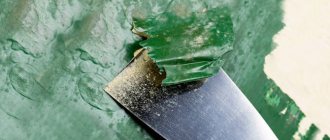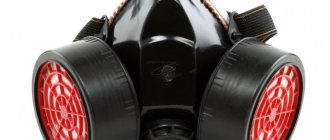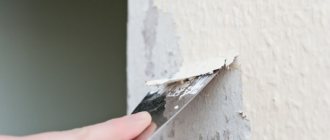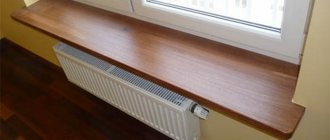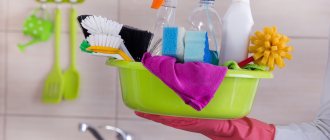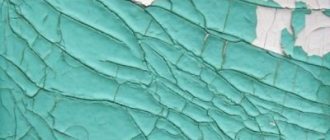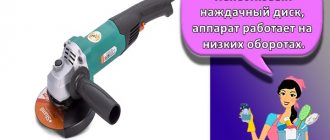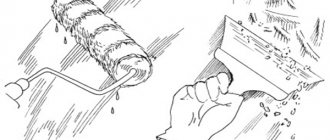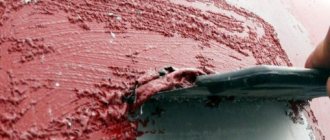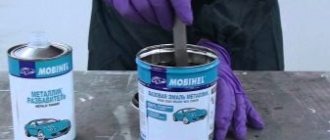Repairs, even the smallest ones, always remain a source of unforeseen problems. Knowing how difficult it is to remove paint from linoleum, most owners prudently cover the floor with paper and film. But even in this case, no one is immune from accidents, so it will be useful to have a product on hand that allows you to remove paint from linoleum. Fortunately, the choice of chemicals and cleaning products is represented on the market by dozens of names.
Universal product for most coloring compounds
Features of removing paint from linoleum
The problem of removing varnish or paint from the surface of a linoleum coating is related to the composition of the polymers on which the front part of the coating is made:
- In the budget and mid-price categories, the top layer is made of varnish, thixotropic paint and polyvinyl chloride, so the material can be easily destroyed by solvents based on nitro compounds, chlorinated hydrocarbons and even classic P646, P647. A careless attempt to clean the paint may remove the protective varnish from the linoleum;
- In commercial and semi-commercial linoleum, a protective film of polyurethane or melamine resin is applied over PVC. It is easier to clean such material, but the risk of surface damage remains.
In addition to polymers, linoleum contains mineral filler and oil softener. The fabric turns out softer and at the same time elastic.
Important! If you try to clean the oil with solvent mixtures, then linoleum, regardless of its age and service life, loses its softener and becomes hard and brittle.
Therefore, you need to clean very quickly, otherwise you can erase the original paint and pattern from the linoleum, and instead of a textured colored surface, a white spot resembling parchment will appear. It is clear that special brands of solvents and removers are used only for heterogeneous types of coatings with an additional protective layer, and only if there is no other way to clean or wash off the paint from linoleum.
How to remove paint from linoleum
Most products for cleaning household items, floors and household items from paint do not contain clear information about their composition. At best, the label will only mention two or three of the most important components. But as a rule, there is no information about what kind of paint stains the floor from and how it can be cleaned. Therefore, before trying to remove paint from linoleum with your own hands, we perform a small experiment:
- We try to wipe it off with water, if the paint is water-soluble, then stains appear on the napkin;
- If there are no stains, drip white spirit from a match onto the paint and blot with a dark cloth. If there is a trace of paint, it means pentaphthalic or nitro paint.
Now you need to decide how to clean. You can’t just rub with a napkin; you need to remove paint stains from the linoleum so that there are no streaks or marks left. Unfortunately, water-soluble paint can become deeply ingrained into the texture of linoleum, leaving colored stripes.
The first step is to blot the stain with a napkin.
How to wipe drops from linoleum flooring
A small spot from dripping paint cannot be rubbed with a rag or napkin. Having blotted the main volume of the paint and varnish material with an easily absorbent cloth or paper, they proceed to viscous abrasion.
To do this, you can take a wooden stick or tube, at the end of which a cotton wool, felt or cotton swab is attached. Next, rotating the makeshift brush, remove the stain without rubbing the paint on the edges. While the contamination is fresh, it is easily transferred to the tampon due to its high viscosity.
How to remove fresh paint from linoleum
Drops that have just been spilled should not be rubbed. The main thing here is to try to quickly remove the paint from the linoleum before the liquid penetrates deeply. If you have already dropped it on the linoleum, then try to blot the stain with a napkin. In order to clean the water emulsion, you can even use wet hand wipes. Just be sure to blot it, and not try to clean it like a grease stain on dishes. Otherwise, you will end up with a huge “stain” that will take a whole day to clean.
You can also blot the nitro paint, first with a dry cloth, then carefully with a cotton swab moistened with nail polish remover. If you don’t immediately see a stain on the linoleum, then it’s better not to try to clean it, you need to wait until it dries. The same applies to pentaphthalic paints, only you need to use solvent 647 or white spirit.
Oil paint can also be left until it dries thoroughly, for 3-4 days, only then try to clean it with turpentine.
Remains of solvent or remover must be washed away with a special floor care product or soda solution.
How to remove old paint from linoleum
Often, drops of paint or varnish on the floor that go unnoticed while painting cause a little panic. In fact, it is often easier to remove dried paint from linoleum than fresh paint. Of course, this does not apply to acrylic and water-based stains. In this case, no matter how old the paint droplets are, you need to try to clean them as quickly as possible:
- Fill with soapy water or soda solution;
- Blot the stain;
- We add soda ash and try to remove the paint from the linoleum.
Nitro paints, pentaphthalic, polyurethane paints dry due to the evaporation of the solvent. Oil and acrylic also interact with oxygen in the air to gain hardness. Therefore, the first ones can be treated with a small amount, soften the stain and clean with the tip of a sharp blade.
The best way to remove a stain without leaving a trace is with a blade.
In order to remove old oil paint from linoleum, the stain can first be heated or treated with turpentine, and only then cleaned with a blade.
Important! In any case, removing dried paint is safer, since there is no risk of smudging around the droplets.
How to remove paint from linoleum
If the mechanical removal of paint and varnish residues is considered a fairly simple and well-established scheme, then the washing process requires extreme care. Cleaning the stain is only half the battle; it is important not to dissolve the outer varnish layer and the design.
Therefore, if there is a suspicion that drops may fall on the floor during the renovation process, then it is better to take preventive measures than to spend ten times more time and effort cleaning the surface.
Protecting linoleum can be done in two ways:
- Cover the floor with film and old newspapers;
- Rub the linoleum in the area to be painted with dry soap or wax mastic.
Floor protection film
Both methods are good because you don’t have to think about how to clean linoleum. In the first case, the newspapers simply go to waste; in the second, you just need to wash the floor with a brush and a cleaning agent. Water and a dissolving layer of soap will help wash off even nitro paint. The most important thing is that it is possible to clean the surface from even the smallest droplets, which are usually not paid attention to when painting.
How to remove oil paint from linoleum
Paintwork materials based on drying oil and turpentine are easily cleaned with kerosene or clarified turpentine. When overheated, the paint becomes viscous, like resin. Usually a plasticine border is made around the stain to prevent the turpentine from spreading. An hour after wetting, the paint can be easily scraped off, then cleaned with soda ash.
Oil-based paints and varnishes are rubbed with turpentine
How to remove acrylic paint from linoleum
In order to clean the textured linoleum covering from acrylic, you will have to work diligently with a plastic brush and dishwashing detergent. If more than an hour has passed since the stain appeared, then a water-alcohol solution is applied to the acrylic stain and left overnight, after which the stain can be cleaned with plenty of water.
A small stain can be cleaned with a spatula after heating it with a hairdryer; if the area of contamination is large enough, then it is better to use a steam generator for dry cleaning of upholstered furniture.
How to remove water-based paint from linoleum
Water-soluble compounds are removed with water and a stiff brush. Apply a water or soap-water compress to the old stain. After a day, the stain can be cleaned off with a stiff-bristled brush.
The water-based emulsion is washed with hot water.
If it was not possible to clean the stain “in hot pursuit” and stains appeared, then you will need to wash the linoleum surface several times with hot water and liquid tile cleaner.
How to Remove Ink from Linoleum
Spilled printer ink eats into the linoleum so firmly that, at first glance, it is simply impossible to clean the paint from the surface. In fact, almost all brands of ink are water-based with the addition of agents that increase the fluidity of the ink solution.
The ink is removed either with a chemical eraser or soda ash.
If the stain was noticed in time, then before the paint dries, you need to blot the ink, but do not try to fill it with water. After the stain has dried, use a stiff brush and a cleaner with a small addition of vinegar. All that remains is to clean up the traces of the ink solution. This can be done with ammonia or a weak 1:10 solution of bleach. The coloring components oxidize and become invisible; residues must be quickly cleaned with cold water.
How to remove varnish from linoleum
If nitro varnish gets on the surface, you can remove it with a small amount of water with acetone and vinegar. A small spot can be removed with a manicure remover.
Pentaphthalic varnishes are very difficult to remove from PVC; it is impossible to wipe off the varnish film with a solvent; the texture and pattern on the floor covering may be damaged. You can only take a risk on commercial linoleum; this material is seriously afraid only of dichloroethane.
The most common mistakes
To completely get rid of paint and not damage the linoleum, you need to familiarize yourself with the main mistakes that people make when trying to remove stains:
Use of abrasive cleaning products. It is possible that they will cope with the coloring composition, but the linoleum will be hopelessly damaged. There will be scratches on it that you will not be able to get rid of.- Use of substances containing chlorine. The use of such compositions threatens the appearance of white spots on the floor covering.
- Mechanical paint removal. You can try to carefully clean off its top layer to facilitate the penetration of the liquid substance. However, scraping the flooring with the edge of a knife or metal spatula is unacceptable.
After finishing cleaning, you need to wash the floor with water. This is done to remove chemical components from linoleum. In the future, they will not corrode the paint of the coating itself.
Tips and tricks
Most of the recipes given have been repeatedly tested in practice, but there is still a risk that it will not be possible to completely clean the paint or remove the stain. If there is doubt about the effectiveness of the method, it is best to use mechanical methods of removing droplets.
The only exceptions are oil-based paints and varnishes. Drying oil or turpentine have a fairly high viscosity and cannot penetrate deep into the pores of the laminate. Plus, a few sessions of heating and cooling will turn a drop of oil paint into a rock-hard material. Removing such a “patch” from linoleum will not be difficult.
Industrial strippers may not be safe for floors
Only paints and varnishes based on chlorinated hydrocarbons stick well to PVC; all other dyes can be wiped off with a brush and cleaning powder with some effort. You will only need to polish the surface with a felt wheel so that the matte area on the linoleum does not stand out too much.
In addition to folk remedies, there are a huge number of solutions on the market for cleaning a wide variety of floor coverings, from linoleum to parquet. They can be used without restrictions; they will not be able to do much harm to linoleum. There is also a whole class of products for quickly removing any paint. They contain turpentine and phosphoric acid. Even pentaphthalic varnish can be easily cleaned with this product, but it can also burn linoleum to holes.
What types of pollution are there?
First, you need to understand what kind of contaminants there are before trying to clean them. The following can form on linoleum:
- grease dirt;
- marks left by products such as mayonnaise;
- drops of iodine, brilliant green, traces of mold, rust;
- marks from a marker, felt-tip pen or ink;
- paint blots;
- dirt of unknown origin (usually pink or red).
Knowing exactly what stain is in front of you, it will be easier to get rid of it by choosing the right method.
Each type of stain has its own removal method.
